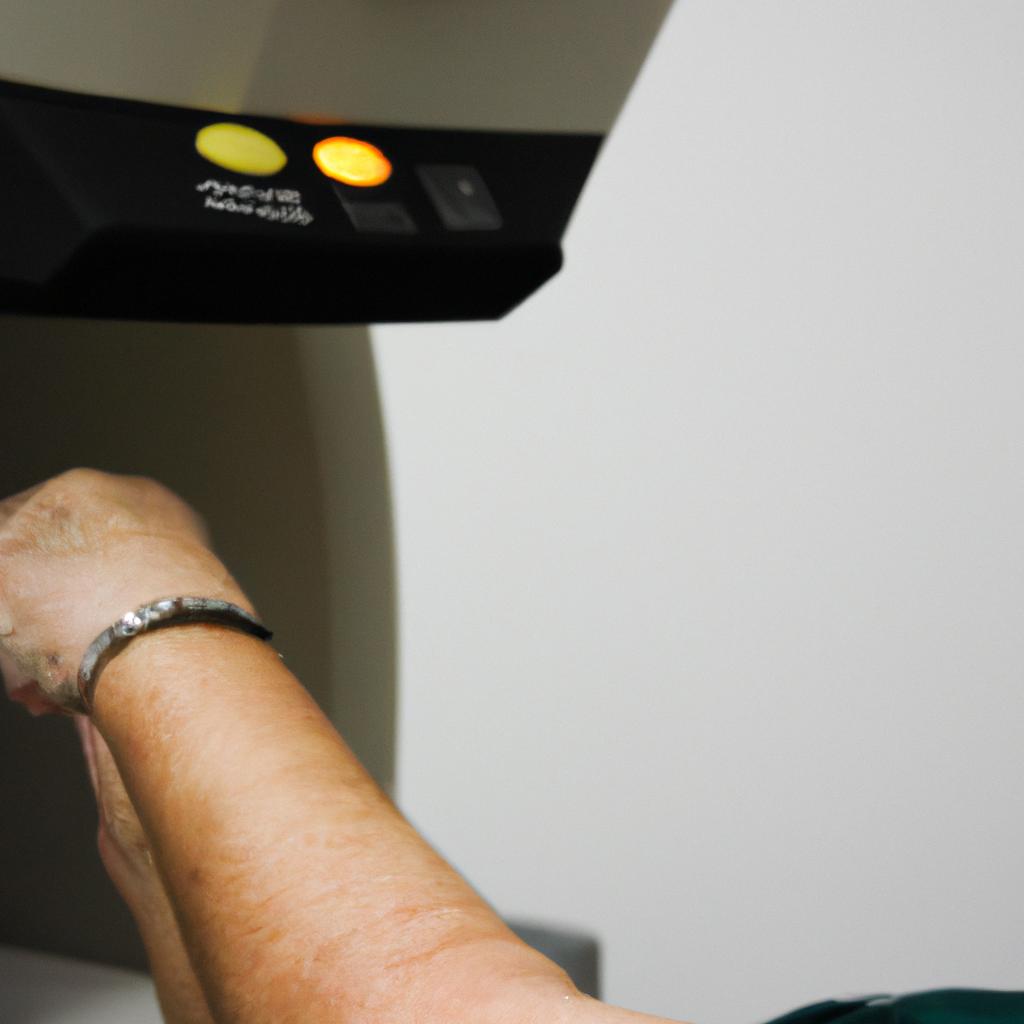Cancer treatment options have evolved over the years, with alternative and complementary therapies gaining popularity as potential adjunctive approaches. These therapies encompass a wide range of practices and interventions that are used alongside conventional medical treatments to provide patients with comprehensive care. For instance, consider the case study of Sarah, a 45-year-old breast cancer survivor who experienced significant physical and emotional distress during her chemotherapy regimen. Seeking additional support, she turned to acupuncture, meditation, and dietary supplements—all forms of alternative and complementary therapies—to alleviate her symptoms and improve her overall well-being.
Alternative therapies refer to non-mainstream practices that are used instead of conventional medical treatments, while complementary therapies are employed alongside standard medical care to enhance its effectiveness or reduce side effects. Such therapies can include but are not limited to herbal remedies, acupuncture, massage therapy, mind-body techniques (e.g., meditation), nutritional supplementation, and energy healing modalities like Reiki. The growing interest in these approaches stems from their potential benefits in addressing various aspects associated with cancer treatment such as pain management, nausea reduction, stress reduction, improved quality of life, enhanced immune function, and increased patient empowerment.
Despite the increasing acceptance and utilization of alternative and complementary therapies by cancer patients worldwide, it is essential for healthcare professionals to approach these therapies with caution and a balanced perspective. While some alternative and complementary therapies have shown promising results in improving patient outcomes, it is crucial to remember that they should not replace evidence-based conventional medical treatments.
Healthcare professionals should educate themselves about different alternative and complementary therapies, their potential benefits, limitations, and possible risks. They can then engage in open and honest conversations with their patients about these options, providing guidance, support, and helping them make informed decisions.
It is important to note that not all alternative and complementary therapies have undergone rigorous scientific research or obtained regulatory approval. Therefore, healthcare professionals should encourage patients to seek information from reputable sources, consult with qualified practitioners who have experience in integrating these therapies into cancer care, and ensure appropriate coordination between conventional medical treatments and any chosen alternative or complementary approaches.
Ultimately, the goal of incorporating alternative and complementary therapies into cancer care is to provide holistic support for patients’ physical, emotional, and spiritual well-being. By working collaboratively with patients, healthcare professionals can help optimize treatment outcomes while respecting individual preferences and beliefs.
Types of Alternative Therapies
One example of an alternative therapy that has gained popularity in recent years is acupuncture. Acupuncture involves the insertion of thin needles into specific points on the body to stimulate energy flow and promote healing. For instance, a study published in the Journal of Pain and Symptom Management reported that patients with cancer who received acupuncture experienced significant reductions in pain intensity compared to those who did not receive this treatment.
Alternative therapies encompass a wide range of practices beyond acupuncture. These include herbal medicine, massage therapy, meditation, and yoga. Herbal medicine involves the use of plants or plant extracts for their therapeutic properties. Massage therapy focuses on manipulating muscles and soft tissues to alleviate tension and improve overall well-being. Meditation aims to calm the mind and enhance inner peace through focusing attention or adopting specific mindfulness techniques. Yoga combines physical postures, breathing exercises, and meditation to promote balance between body and mind.
While alternative therapies offer potential benefits, it’s important to approach them with caution as they may not be suitable for everyone or have scientific evidence supporting their efficacy. It is crucial for individuals considering these options to consult healthcare professionals and seek reliable information before incorporating them into their treatment plan.
In exploring alternative therapies, it becomes evident that emotional well-being plays a significant role in cancer care. The following bullet point list highlights some emotional aspects related to complementary therapies:
- Provides a sense of control over one’s health journey
- Enhances relaxation and reduces stress levels
- Fosters a positive outlook on life during challenging times
- Promotes feelings of empowerment amidst medical treatments
Moreover, understanding different types of alternative therapies can help individuals make informed decisions about which approaches align best with their personal beliefs and values.
| Therapy | Description | Benefits |
|---|---|---|
| Acupuncture | Involves needle insertion at specific points | Reduces pain intensity |
| Herbal Medicine | Use of plants or plant extracts for therapeutic purposes | Offers natural remedies |
| Massage Therapy | Manipulation of muscles and soft tissues | Alleviates tension and enhances well-being |
| Meditation | Focuses on calming the mind | Promotes inner peace |
By considering both emotional aspects and available alternative therapies, individuals can explore complementary treatments that may enhance their overall well-being.
Evidence-Based Complementary Therapies
Alternative Therapies: Expanding Treatment Options
Imagine a patient named Sarah who has been diagnosed with breast cancer. Alongside conventional medical treatments, she decides to explore alternative and complementary therapies to enhance her overall well-being during the treatment process. In this section, we will discuss some common types of alternative therapies that cancer patients like Sarah may consider.
Alternative therapies encompass a wide range of practices that are not typically included in mainstream medical care. These approaches aim to promote healing, reduce side effects, and improve quality of life for individuals undergoing cancer treatment. Some examples include:
- Acupuncture: This ancient Chinese practice involves inserting thin needles into specific points on the body to stimulate energy flow and restore balance.
- Mind-body techniques: Practices such as meditation, yoga, and guided imagery help individuals cope with stress, manage pain, and foster a sense of relaxation.
- Herbal remedies: Certain herbs and plants have been used traditionally to alleviate symptoms associated with cancer or its treatment. For instance, ginger is believed to relieve nausea caused by chemotherapy.
- Dietary supplements: Some cancer patients turn to dietary supplements like vitamins, minerals, or botanical extracts in an attempt to support their immune system or counteract nutrient deficiencies.
While these alternative therapies can offer potential benefits, it’s essential to approach them with caution. It is important to note that evidence supporting their effectiveness varies greatly across different treatments. To provide you with more comprehensive information about the efficacy of each therapy discussed above, please refer to the subsequent section on “Evidence-Based Complementary Therapies.”
To further illustrate the diverse landscape of alternative therapies available today, let us delve into a table highlighting various therapeutic interventions along with their purported emotional impacts:
| Therapy | Emotional Impact |
|---|---|
| Acupuncture | Promotes relaxation and reduces anxiety |
| Mindfulness | Cultivates self-awareness and emotional well-being |
| Herbal remedies | Offers a sense of control and empowerment |
| Dietary supplements | Provides hope and reassurance in supporting the body |
It’s crucial for individuals considering alternative therapies to consult with their healthcare providers. This ensures that these practices are integrated safely alongside conventional treatments, minimizing potential risks or adverse interactions.
Transitioning into the subsequent section on “Potential Benefits and Risks,” let us explore how evidence-based research can shed light on the efficacy and safety of complementary therapies.
Potential Benefits and Risks
Section Title: Exploring the Efficacy of Complementary Therapies
Case Study:
To illustrate the potential benefits and risks associated with alternative and complementary therapies, let us consider a hypothetical case study. Sarah, a 45-year-old woman diagnosed with breast cancer, decides to pursue complementary therapies alongside her conventional treatment plan. She incorporates acupuncture sessions into her routine, hoping to alleviate chemotherapy-induced nausea and improve overall well-being.
Exploring Potential Benefits:
While evidence-based research on complementary therapies is still evolving, proponents highlight several potential benefits that individuals like Sarah may experience when integrating these treatments into their cancer care journey. These include:
- Improved Quality of Life: Many patients report an enhanced sense of well-being while undergoing complementary therapies such as yoga or massage.
- Reduced Treatment Side Effects: Some studies suggest that certain interventions like acupuncture can help manage symptoms commonly associated with cancer treatments, including pain, fatigue, and nausea.
- Psychological Support: The holistic approach of many complementary therapies addresses not only physical but also emotional aspects of health. This support may positively impact mental well-being during treatment.
- Empowerment and Active Participation: Engaging in complementary therapies encourages patients to take an active role in their own healing process, promoting a sense of empowerment and control over one’s health.
Table Example (Benefits vs. Risks):
| Potential Benefits | Associated Risks |
|---|---|
| Enhanced quality of life | Lack of scientific evidence |
| Reduction in treatment side effects | Interference with conventional treatments |
| Emotional support | Financial burden |
| Patient empowerment | Potential delay in seeking effective medical intervention |
Risks and Considerations:
It is crucial to acknowledge the potential risks and limitations surrounding alternative and complementary therapies for cancer treatment. While some individuals may find relief through these methods, it is important to exercise caution due to factors such as lack of rigorous scientific evidence supporting efficacy claims or possible interference with conventional treatments. Additionally, financial implications and the potential delay in seeking effective medical interventions should be taken into account.
With an understanding of these factors, it is essential to explore integrative approaches that combine conventional cancer treatments with evidence-based complementary therapies. In the following section, we delve into the concept of integrative medicine and its growing role in comprehensive cancer care strategies.
Integrative Approaches to Cancer Treatment
Section H2: Integrative Approaches to Cancer Treatment
Having explored the potential benefits and risks of alternative and complementary therapies, it is crucial to consider integrative approaches when seeking optimal cancer treatment options. By combining conventional medical treatments with complementary therapies, patients can potentially enhance their overall well-being and improve treatment outcomes. To illustrate this concept, let us examine a hypothetical case study.
Case Study: Sarah, a 45-year-old breast cancer patient, underwent surgery followed by chemotherapy as part of her conventional cancer treatment plan. However, she experienced significant side effects such as fatigue, nausea, and anxiety. Seeking additional support, Sarah decided to incorporate integrative therapies into her treatment regimen.
Integrative approaches aim to address physical symptoms while promoting mental and emotional well-being. Here are some key elements that underline the effectiveness of these approaches:
- Holistic Approach: Integrative therapies take into account the whole person rather than focusing solely on the disease itself. This approach recognizes that each individual’s experience with cancer is unique and requires personalized care.
- Supportive Care: Complementary therapies provide supportive care by alleviating common side effects associated with conventional treatments like pain, insomnia, stress reduction during diagnosis or examination procedures.
- Enhanced Quality of Life: Integrative approaches focus not only on curing the disease but also improving patients’ quality of life throughout their cancer journey.
- Empowerment: These therapeutic interventions empower individuals to actively participate in their healing process by providing them with tools and techniques for self-care management.
Table Example – Emotional Response Evoking Table
| Therapy Type | Benefits | Limitations | Evidence |
|---|---|---|---|
| Acupuncture | Pain relief | Possible adverse reactions | Growing body of research |
| Yoga | Stress reduction | Physical limitations | Positive impact on well-being |
| Meditation | Improved mental clarity | Difficulty in practice | Positive effects on anxiety |
| Art Therapy | Emotional expression | Limited availability | Promising results reported |
By incorporating integrative therapies into her treatment plan, Sarah experienced a significant reduction in chemotherapy-related side effects. Acupuncture provided relief from pain and nausea, while yoga and meditation helped manage her stress levels effectively. Additionally, engaging in art therapy allowed her to express her emotions and find solace during challenging times.
As we delve further into exploring alternative methods of cancer treatment, let us now turn our attention to mind-body therapies that have shown promise in supporting individuals throughout their cancer journey.
Mind-Body Therapies
Integrative Approaches to Cancer Treatment have gained popularity in recent years due to their potential benefits in improving patients’ well-being and overall treatment outcomes. In this section, we will explore another category of alternative and complementary therapies known as Mind-Body Therapies.
To illustrate the potential effectiveness of these therapies, let’s consider a hypothetical case study: Sarah, a breast cancer patient undergoing chemotherapy, experiences high levels of stress and anxiety throughout her treatment journey. She decides to try mind-body therapies to help manage her emotional well-being. Through regular practice of meditation and relaxation techniques, Sarah finds that her stress levels decrease significantly, allowing her to better cope with the challenges she faces during her treatment.
Mind-Body Therapies encompass various practices that focus on the connection between the mind and body in promoting healing and enhancing overall health. Some commonly used approaches include:
- Meditation: This technique involves training the mind to achieve a state of deep concentration and relaxation. It has been shown to reduce anxiety, improve sleep quality, and enhance psychological well-being.
- Yoga: Combining physical postures (asanas), breathing exercises (pranayama), and meditation, yoga promotes flexibility, strength, balance, and inner peace.
- Tai Chi: An ancient Chinese martial art form characterized by slow movements and deep breathing techniques that promote relaxation, mental clarity, and physical coordination.
- Guided Imagery: This practice involves using one’s imagination to create positive mental images or scenarios for healing purposes.
These mind-body therapies not only provide patients like Sarah with a sense of empowerment but also offer potential physiological benefits such as reduced inflammation markers and improved immune function.
| Therapy | Benefits |
|---|---|
| Meditation | – Reduces anxiety |
| – Improves sleep quality | |
| – Enhances psychological well-being | |
| Yoga | – Promotes flexibility and strength |
| – Enhances balance | |
| – Cultivates inner peace | |
| Tai Chi | – Promotes relaxation |
| – Improves mental clarity | |
| – Enhances physical coordination | |
| Guided Imagery | – Facilitates healing through positive imagery |
As we delve deeper into the realm of alternative and complementary therapies, it becomes evident that mind-body techniques can play a significant role in supporting cancer patients’ overall well-being. In the subsequent section, we will explore another category of treatments: Natural Supplements and Herbal Remedies. By examining their potential benefits and risks, we aim to provide a comprehensive overview of available options for those seeking integrative approaches to cancer treatment.
Natural Supplements and Herbal Remedies
In recent years, there has been growing interest in utilizing natural supplements and herbal remedies as alternative or complementary therapies for cancer treatment. These modalities aim to harness the potential benefits of various plant-based substances in managing symptoms, improving quality of life, and potentially even combating the disease itself. While scientific evidence regarding their efficacy is still limited, exploring these options opens up new avenues for patients seeking additional support alongside conventional medical treatments.
Case Study: To exemplify the potential impact of natural supplements and herbal remedies on cancer treatment, consider the hypothetical case study of Sarah. A 45-year-old breast cancer patient undergoing chemotherapy experiences significant fatigue as a side effect. After discussing with her healthcare team, she decides to incorporate ginseng into her daily routine to combat this exhaustion based on anecdotal evidence suggesting its energy-boosting properties.
To better understand the landscape surrounding natural supplements and herbal remedies in cancer treatment, it is important to explore different aspects associated with their usage:
- Potential Benefits: Proponents claim that certain natural supplements and herbal remedies have anti-inflammatory properties, antioxidant effects, immune-enhancing capabilities, or can mitigate side effects from conventional treatments.
- Safety Concerns: Despite being derived from natural sources, these interventions are not without risks. Potential adverse reactions such as drug interactions should be carefully considered before incorporating them into a treatment plan.
- Regulatory Challenges: Due to limited regulation within the supplement industry compared to pharmaceutical drugs, ensuring product safety and consistency can pose challenges.
- Scientific Evidence: The overall lack of rigorous clinical trials makes it difficult to draw definitive conclusions about the effectiveness of these therapies.
| Supplement | Claimed Benefit | Scientific Evidence |
|---|---|---|
| Turmeric | Anti-inflammatory | Limited research available |
| Green tea | Antioxidant | Some studies show potential |
| Milk thistle | Liver protection | Insufficient evidence |
| Essiac tea | Cancer-fighting properties | Lack of scientific consensus |
While natural supplements and herbal remedies offer a potentially appealing adjunct to conventional cancer treatments, it is essential for patients considering these options to consult with their healthcare team. Engaging in an open dialogue ensures that any possible benefits are balanced against safety concerns and aligns with the overarching treatment plan developed by medical professionals.
In summary, exploring alternative therapies such as natural supplements and herbal remedies can provide individuals undergoing cancer treatment with additional avenues for support. However, due to limited scientific evidence and regulatory challenges associated with these interventions, careful consideration should be given before incorporating them into one’s treatment regimen. By fostering collaboration between patients and healthcare providers, informed decisions can be made regarding the potential risks and benefits of utilizing these modalities alongside conventional approaches.
 Web Firma
Web Firma



